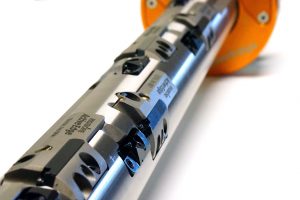Steed Webzell looks at edge computing and the hardware requirements for those looking to digitally monitor, measure or control their machining operations 
Certain terms surrounding digitisation have become pretty familiar over the past 5-10 years: Internet of Things, Industry 4.0 (I4.0), edge computing, big data, smart factory, artificial intelligence (AI), augment reality (AR), virtual reality (VR), machine learning and many more besides. Precise definitions are disputed, with most meaning different things to different manufacturers.
In turn, it comes as little surprise that some have trouble picturing exactly what these concepts demand in terms of actual hardware. Take edge computing as an example. Some manufacturers are working to understand how it can be put to good use in the automotive industry. At machine tool specialist Heller, the company has realised how it can best leverage edge computing.
The concepts developed to achieve advantages in machining by means of digitisation are all based on production data, namely information modules that not only have a temporal reference, but a specific number value, and which are generated as part of the process.
Insights into production performance
Process data is generated non-stop and already used today for important functions such as tool overload and tool breakage monitoring. However, what if it were possible to actually anticipate failures? Bernd Zapf, Heller’s head of development, new business and technology, believes this very ambition tops the current wish lists of automotive production managers.
“Concepts such as Industry 4.0 give us the means to gain deeper insights into the process correlations of machine tools, or more specifically their hardware – the electronic and electro-technical systems – making it possible to derive practical advantages and provide considerable added value in everyday production.”
In day-to-day operations, this process entails providing machines with the capability to network and organise data traffic in a meaningful and secure way. So, what of the hardware required for such a task? Well, in co-operation with Siemens, Heller has developed an edge computer housed in a small grey box called Sinumerik-Edge that performs a number of functions.
“The edge computer currently offers the most secure way of providing machine tools with network capabilities,” says Zapf. “Both in terms of the physical design – since the input and output signals in the box are technically separate from one another – and with regard to the encryption and identification management, which often exceeds the security standards of regular corporate networks.”
The relevant data is extracted with Sinumerik-Edge, marked with a time stamp and pre-processed for further use. Users decide whether they only want to integrate the machine tool into the corporate network on a control station level, or if they want to connect it to Siemens’ cloud environment, the so-called Mindsphere.
Ultimately, as part of a cascaded networking solution, using either the corporate network (private cloud) or an internet-based connection to Mindsphere, the edge computer (as the key hardware component) gives companies with different requirements access to Heller’s value-added services, the latest additions to which include a ‘Collision Avoidance’ application.
In short, a system such as Sinumerik Edge is the facilitator, where computation is based on individual machine and axis data. Hardware in the form of a control-based interface allows the machine to be programmed directly using Sinumerik Edge-based computational power. This configuration prevents any adverse effects on machining performance.
Hardware retrofitting
This distributed computing paradigm offers potential in applications right along the supply chain, not just for OEMs. UK manufacturer of suspension parts for truck applications, Tinsley Bridge has recently been working with engineers at the University of Sheffield’s Advanced Manufacturing Research Centre (AMRC) Factory 2050, who are using AI to learn what machine utilisation looks like on the shop floor of the Sheffield-based SME. Hardware, in the form of a demonstrator, will be created to highlight the accessibility of I4.0 technologies and the potential benefits for shop-floor productivity.
“Using hardware such as edge-computing devices retrofitted to the company’s CNC machines, we have collected power consumption data during the production of automotive suspension components,” says Rikki Coles, AI project engineer for the AMRC’s Integrated Manufacturing Group at Factory 2050. “It isn’t a complicated parameter to measure on a CNC machine, but using AI and machine learning, we can actually do a lot with this simple data. The project demonstrates to industry that, with a low-cost hardware device collating quite simple data, AI and machine learning can be used to create valuable insights for the manufacturer.”
Director of engineering at Tinsley Bridge, Russell Crow, adds: “Interrogating our machine utilisation rates means we have better visibility of what was being manufactured and when, and the ability to assess if we are scheduling effectively. This data will allow us to look at boosting our productivity on the shop floor. Rather than investing in significant cost and time for new, digitally integrated machining centres, we have been able to work with the AMRC to retrofit our existing capabilities, and thus attain the same results and enhance what data we were collecting. This was achieved by fitting hardware, in the shape of a simple current clamp, to our machines; an unobtrusive solution that caused no disruption or downtime.”
Aiden Lockwood, chief enterprise architect for the AMRC Group, says the project demonstrator will highlight the accessibility and affordability of Industry 4.0 technologies to other SMEs: “Traditionally, these tools were built into commercial packages which could be out of reach for some SMEs, so there is a misunderstanding that I4.0 manufacturing techniques are only for big players who handle incredibly complex data collected over long periods of time. However, AI is evolving and these techniques now give smaller manufacturers the ability to do much more with their data.”
The next phase of the project will see AMRC engineers train the system further, so the algorithm can detect non-conforming components while in production, or identify a problem when a machine requires intervention, such as when a tool is showing inconsistent wear and impacting component quality.
“At the start we wanted to find out about retrofitting our machines for data capture, to give us an idea of machine utilisation so that we could optimise production schedules,” says Crow. “However, as the project moves forward, we expect to gain even more visibility around our production processes, so we can begin to move towards a predictive maintenance model in our machine shop that will provide improvements in quality and process capability.”
To demonstrate the ease with which even old machine tools can be readied for digitisation, the AMRC recently retrofitted a 1956 Colchester Bantam lathe with low-cost sensing equipment. Indeed, hardware such as sensors can today be fitted to all sorts of machining-related technologies, including vices and cutting tools.
Roemheld, for example, has recently released a vice with intelligent sensors that facilitates the safe clamping of workpieces on machine tools, as well as real-time production monitoring. The HPC vice incorporates electronics that measures clamping forces in real time and compares them with pre-set target and limit values. Results are transmitted wirelessly to stationary or mobile receivers on which an associated app is installed. Measurements take half a second and detect changes in clamping force from 50N.
Cutting tool manufacturers are also becoming highly active in this technology area, as Sandvik Coromant can demonstrate with its CoroPlus ProcessControl monitoring solution. The system, which includes hardware, software, installation and support, is designed to increase overall in-cut process stability and security. In terms of hardware infrastructure, monitoring devices can be mounted in the machine tool’s electrical cabinet, close to the PLC, while sensors are fitted close to the work zone. Some installations will require a separate operator panel module.
Automated process compensation
 An engine manufacturer is using Rigibore’s Zenith boring system with auto compensation
An engine manufacturer is using Rigibore’s Zenith boring system with auto compensationAnother cutting tool specialist, Rigibore, says that an engine manufacturer has gained total control over its boring processes thanks to the introduction of the company’s automated boring tool compensation system, Zenith. The system was selected for its ability to make compensations automatically from measurement data to an accuracy of 1µm on diameter. Maintaining much closer machining tolerances on crankshaft bearing journals not only enhances the quality of the finished component, but has a direct impact on engine efficiency and emissions.
The idea was to produce line boring bars with five semi-finish cartridges set 0.1mm below nominal, thus allowing five ActiveEdge finish cartridges to machine all journals in a single pass. The ActiveEdge line bars were automatically compensated to nominal from data provided by offline gauging that was transferred to the machine control as part of the Zenith closed-loop system.
Prior to installing ActiveEdge tools, the customer carried out verification checks to confirm that each cartridge could be adjusted independently in increments of 0.001mm on diameter. With this ability confirmed, an extended live cutting trial was instigated. The trial took place on a twin-spindle machining centre, with each spindle machining 946 crankshaft bores over a 24-hour period, so 1892 in total. In this time, not a single bore was out of tolerance thanks to ActiveEdge’s intervention. The finished bores had a mean diameter of 52.965mm with a tolerance of ±0.015mm. During the test period, bore sizes were maintained within a variance of just 2µm.
Before installing the tooling, the engine manufacturer had two line bars running on a multi-spindle CNC. An operator would use a dial indicator and adjust each individual cutting edge manually. The process of ensuring nominal size before the production run took 45 minutes on average. In contrast, Zenith allows automatic, individual cutting edge compensations to be made with the tool located anywhere in the machine, completing the setting process after an insert change within a matter of minutes.
Ultimately, it is clear that shops embracing digitisation have much better information with which to operate their machining operations and businesses. Moreover, the hardware required is relatively simple.
Machine tool components get smart
SKF has further expanded its offering in condition monitoring with a compact system that is flexible enough to be used across a spectrum of machine tool applications. The Multilog IMx-16Plus will help machine tool users to reduce unplanned downtime, improve asset availability and optimise operation, particularly in applications that would previously have been too costly to consider.
With the ability to monitor everything from a single machine to an entire plant from a central location, the Multilog IMx-16Plus unit receives condition monitoring signals from vibration or temperature sensors, and can monitor all types of rotating machine tool parts, including pumps, motors and fans.
On the subject of pumps, Wanner has introduced intelligent control for its Hydra-Cell pumps that it claims will generate significant savings while simultaneously improving machined part quality.
High-pressure coolant pumps are traditionally set to accommodate the tool in the carousel that demands the largest coolant flow requirement. When tools with smaller orifices are employed, the unrequired coolant is returned to the supply tank through a bypass valve. This system is wasteful of power, heats up the coolant unnecessarily and reduces the life of the pump itself.
Hydra-Cell intelligent pump control is an open-loop system without pressure gauges or complex electrical feedback loops. The system delivers the correct flow of coolant to maintain the required system pressure, regardless of tool size. As well as reducing the power requirement, coolant chillers can be smaller (consuming less energy). Pump stress is also reduced, thus extending operating life.





































